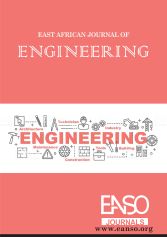Development of a Maintenance Management System for Enhancing the Maintainability Performance of Masonry Commercial Building Structures: A Case of Bungu Ward - Kibiti District Council
Abstract
The maintainability performance of masonry commercial building structures in developing regions faces significant challenges due to inadequate maintenance management systems. This study developed a comprehensive maintenance management system to enhance the maintainability performance of masonry commercial buildings in Bungu Ward, Kibiti District Council, Tanzania. Using a mixed-methods research design, the study assessed 63 commercial buildings to identify critical factors affecting maintainability performance through Relative Importance Index (RII) analysis. A multiple regression model was developed and validated to predict maintainability performance based on seven key factors: structural movement, salt crystallisation, masonry cleaning viability, render/coating condition, foundation-wall interface, damp penetration, and load-bearing capacity. The regression model demonstrated strong predictive power with R² = 0.770, explaining 77% of the variance in maintainability performance (F = 27.922, p < 0.001). Validation testing across five buildings showed performance scores ranging from 82% (Very Good) to 16% (Very Severe), confirming the model's discriminatory capability. A digital Building Structure Maintenance Management System (BSMMS) was developed using Python, featuring modules for building inspection, team management, performance reporting, and predictive maintenance scheduling. The system successfully standardised maintenance protocols and enabled evidence-based decision-making for resource allocation. The study concludes that systematic, evidence-based maintenance management significantly improves building performance and sustainability. The developed system provides stakeholders with practical tools for proactive maintenance planning, ultimately extending building lifespan and reducing lifecycle costs. These findings contribute valuable insights for building maintenance management in similar developing contexts and establish a framework for sustainable commercial building management.
Downloads
References
Au-Yong, C. P., Ali, A. S., & Ahmad, F. (2014). Improving occupants' satisfaction with effective maintenance management of HVAC system in office buildings. Automation in Construction, 43, 31-37.
CHEW, Y. L., Michael, Asmone, A., & Conejos, S. (2018). Design for maintainability: benchmarks for quality buildings. World Scientific.
Chuan, C. L., & Penyelidikan, J. (2006). Sample size estimation using Krejcie and Morgan and Cohen statistical power analysis: A comparison. Jurnal Penyelidikan IPBL, 7(1), 78-86.
Dunston, P. S., & Williamson, C. E. (1999). Incorporating maintainability in constructability review process. Journal of Management in Engineering, 15(5), 56-60.
Ganisen, S., Mohammad, I. S., Nesan, L. J., Mohammed, A. H., & Kanniyapan, G. (2015). The identification of design for maintainability imperatives to achieve cost effective building maintenance: A delphi study. Jurnal Teknologi (Sciences & Engineering), 77(30).
Hair, J., Black, W., Babin, B., & Anderson, R. (2010). Advanced diagnostics for multiple regression: A supplement to multivariate data analysis. In: Pearson Prentice Hall Publishing Upper Saddle River, NJ, USA:
Kheradranjbar, M., Mohammadi, M., & Rafiee, S. (2022). Appropriate building repair and maintenance strategies using multicriteria decision-making analysis–a Delphi study. Acta Structilia, 29(1), 86-111.
MINJA, G. P., & SHISHIWA, J. (2022). Factors affecting maintenance of buildings in public secondary schools in Tanzania.
Motawa, I., & Almarshad, A. (2013). A knowledge-based BIM system for building maintenance. Automation in Construction, 29, 173-182.
Ofori, I., Duodu, P. M., & Bonney, S. O. (2015). Establishing factors influencing building maintenance practices: Ghanaian perspective. Journal of economics and sustainable development, 6(24), 184-193.
Olanrewaju, A. L., Khamidi, M. F., & Idrus, A. (2010). Building maintenance management in a Malaysian university campuses: a case study. Australasian Journal of Construction Economics and Building, The, 10(1/2), 101-114.
Ross, T. J. (2005). Fuzzy logic with engineering applications. John Wiley & Sons.
Saaty, T. L. (2008). Decision making with the analytic hierarchy process. International journal of services sciences, 1(1), 83-98.
Sakketa, T. G. (2022). Urbanisation and rural development in developing countries: A review of pathways and impacts. Discussion Paper.
Sari, A. A. (2018). Understanding Facilities Management Practices to Improve Building Performance: The opportunity and challenge of the facilities management industry over the world. MATEC Web of Conferences,
Silva, A., De Brito, J., & Gaspar, P. L. (2016). Methodologies for service life prediction of buildings: with a focus on façade claddings. Springer.
Copyright (c) 2025 Fredrick Emmanuel

This work is licensed under a Creative Commons Attribution 4.0 International License.




























